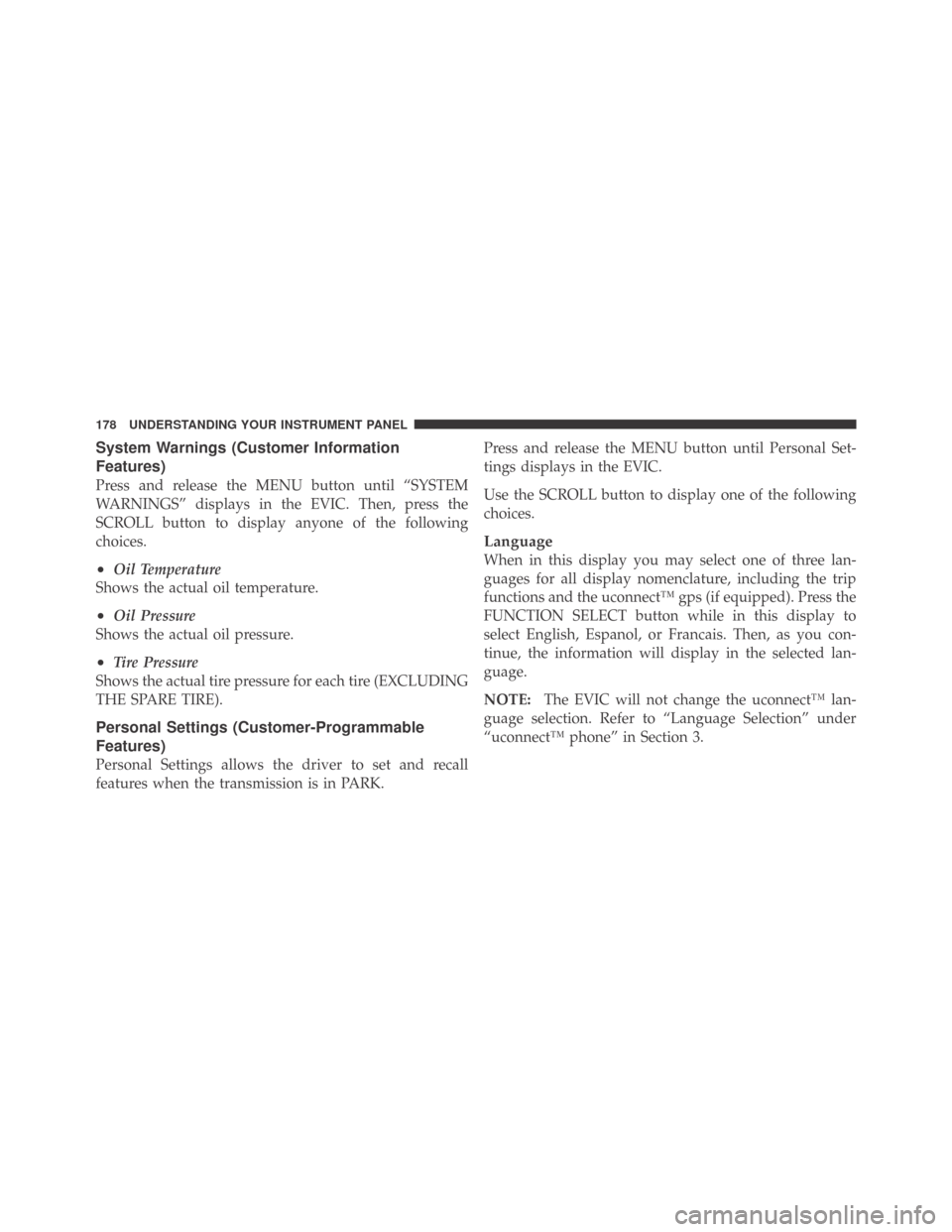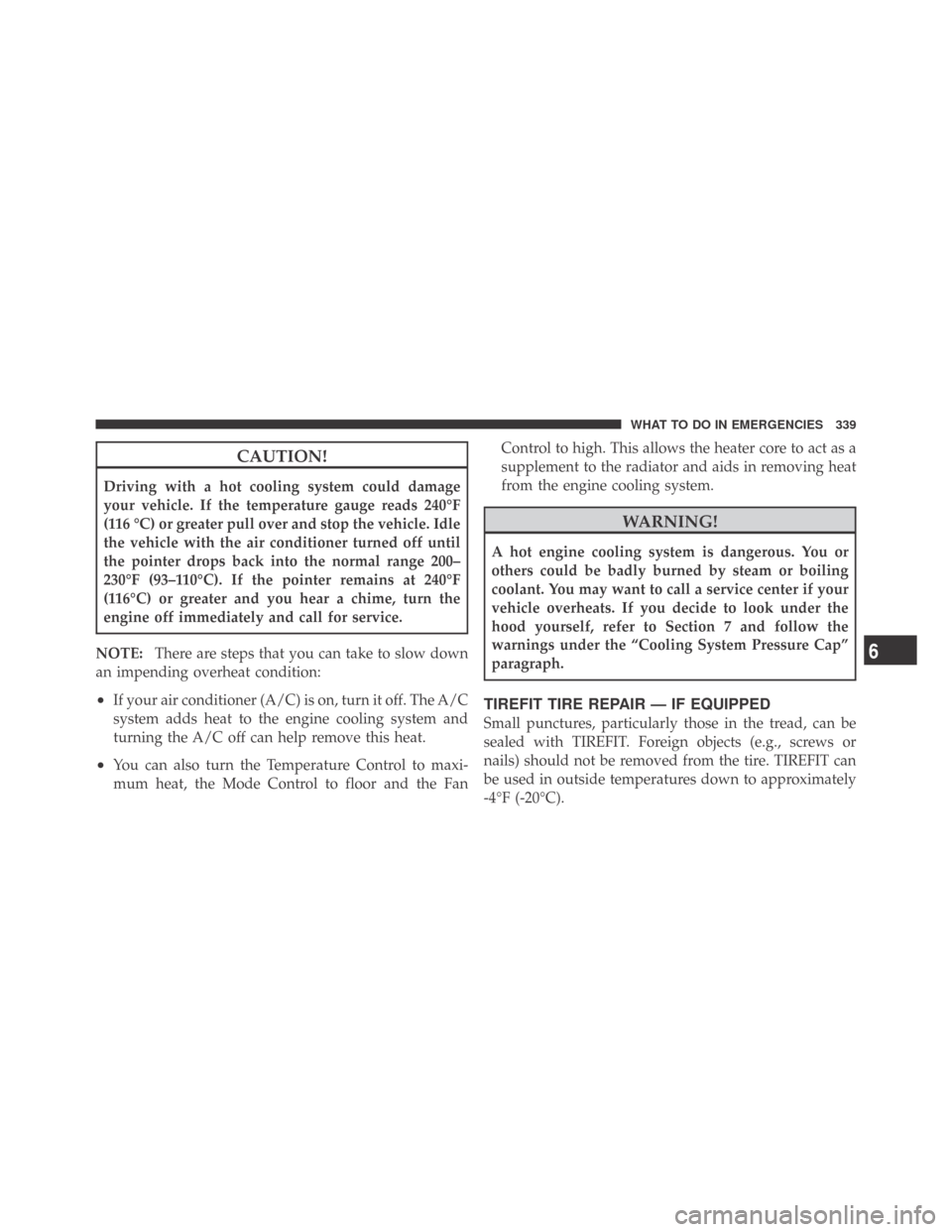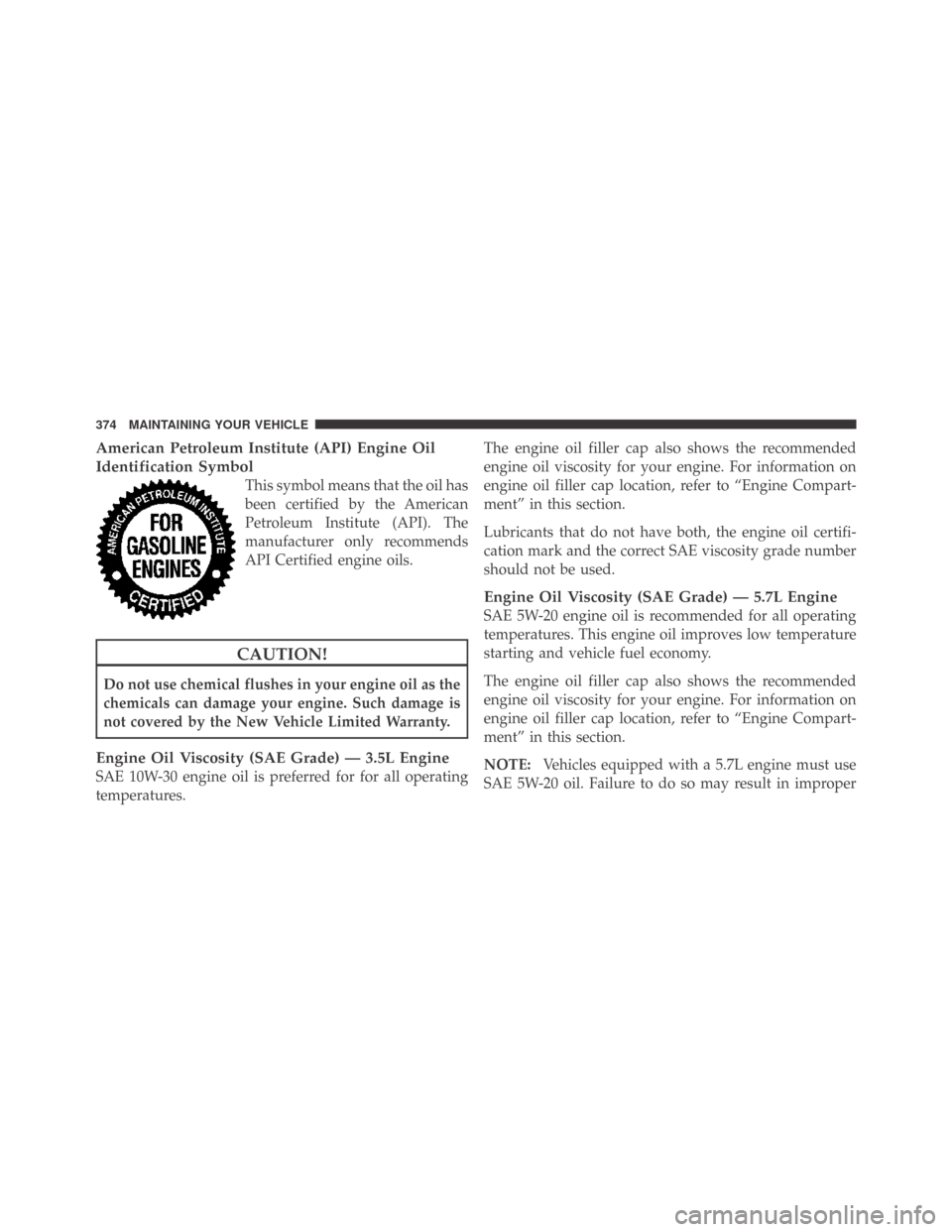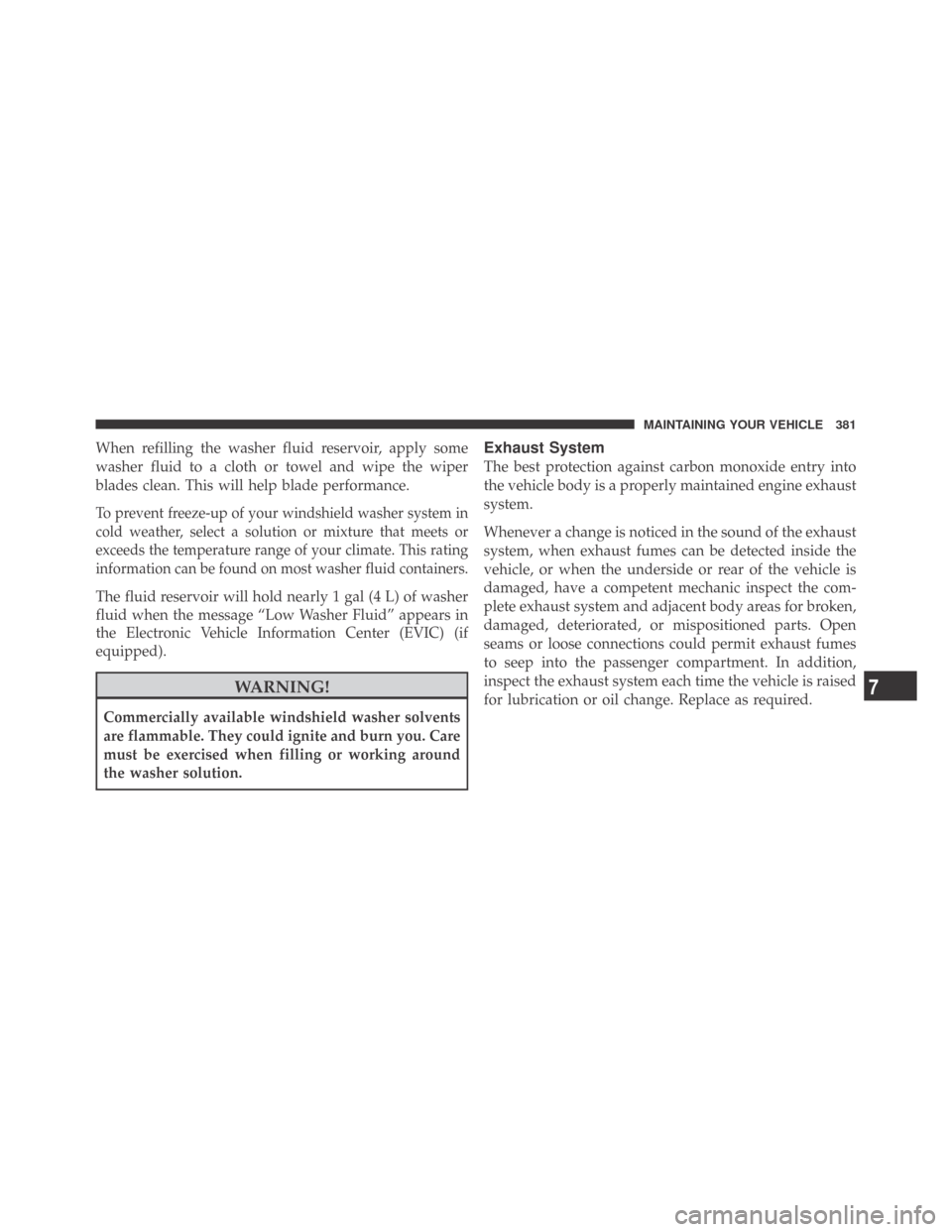2009 DODGE CHALLENGER oil temperature
[x] Cancel search: oil temperaturePage 160 of 469

CAUTION!
Driving with a hot engine cooling system could
damage your vehicle. If the temperature gauge reads
“H,” pull over and stop the vehicle. Idle the vehicle
with the air conditioner turned off until the pointer
drops back into the normal range. If the pointer
remains on the “H,” and you hear a chime, turn the
engine OFF immediately and call for service.
WARNING!
A hot engine cooling system is dangerous. You or
others could be badly burned by steam or boiling
coolant. You may want to call a service center if your
vehicle overheats. If you decide to look under the
hood yourself, refer to Section 7 and follow the
warnings under the Cooling System Pressure Cap
paragraph.9. Turn Signal Indicators
The arrow will flash with the exterior turn signal
when the turn signal lever is operated.
NOTE:
•A continuous chime will sound if the vehicle is driven
more than 1 mile (1.6 km) with either turn signal on.
•Check for an inoperative outside light bulb if either
indicator flashes at a rapid rate.
10. Airbag Warning Light
This light will turn on for six to eight seconds
as a bulb check when the ignition switch is first
turned ON. If the light is either not on during
starting, turns on while driving, or stays on,
have the system inspected at an authorized dealer as
soon as possible.
158 UNDERSTANDING YOUR INSTRUMENT PANEL
Page 180 of 469

System Warnings (Customer Information
Features)
Press and release the MENU button until “SYSTEM
WARNINGS” displays in the EVIC. Then, press the
SCROLL button to display anyone of the following
choices.
•Oil Temperature
Shows the actual oil temperature.
•Oil Pressure
Shows the actual oil pressure.
•Tire Pressure
Shows the actual tire pressure for each tire (EXCLUDING
THE SPARE TIRE).
Personal Settings (Customer-Programmable
Features)
Personal Settings allows the driver to set and recall
features when the transmission is in PARK.Press and release the MENU button until Personal Set-
tings displays in the EVIC.
Use the SCROLL button to display one of the following
choices.
Language
When in this display you may select one of three lan-
guages for all display nomenclature, including the trip
functions and the uconnect™ gps (if equipped). Press the
FUNCTION SELECT button while in this display to
select English, Espanol, or Francais. Then, as you con-
tinue, the information will display in the selected lan-
guage.
NOTE:The EVIC will not change the uconnect™ lan-
guage selection. Refer to “Language Selection” under
“uconnect™ phone” in Section 3.
178 UNDERSTANDING YOUR INSTRUMENT PANEL
Page 259 of 469

WARNING!
Unintended movement of a vehicle could injure
those in and near the vehicle. As with all vehicles,
you should never exit a vehicle while the engine is
running. Before exiting a vehicle, you should always
shift the transmission into PARK, remove the key
from the ignition, and apply the parking brake. Once
the key is removed from the ignition, the transmis-
sion shift lever is locked in the PARK position,
securing the vehicle against unwanted movement.
Furthermore, you should never leave unattended
children inside a vehicle.
Over-Temperature Mode
The transmission electronics constantly monitor the
transmission oil temperature. If the transmission exceeds
normal operating temperature, the transmission will
change the way it shifts to help control the condition.This may result in a slightly different feeling or response
during normal operation in DRIVE position. After the
transmission cools down, it will return to normal
operation.
Brake/Transmission Shift Interlock System
This vehicle is equipped with a Brake Transmission Shift
Interlock (BTSI) system that holds the shift lever in the
PARK position when the ignition switch is in the LOCK
position and the engine is not running. To move the shift
lever out of the PARK position, the ignition switch must
be turned to any other ignition position (ACC, ON/
RUN) position, and the brake pedal must be pressed
whether or not the engine is running.
Brake/Transmission Interlock Manual Override
There is an override for the BTSI that allows you to move
the shift lever out of the PARK position if an electrical
system malfunction occurs (i.e., dead battery). To access
5
STARTING AND OPERATING 257
Page 341 of 469

CAUTION!
Driving with a hot cooling system could damage
your vehicle. If the temperature gauge reads 240°F
(116 °C) or greater pull over and stop the vehicle. Idle
the vehicle with the air conditioner turned off until
the pointer drops back into the normal range 200–
230°F (93–110°C). If the pointer remains at 240°F
(116°C) or greater and you hear a chime, turn the
engine off immediately and call for service.
NOTE:There are steps that you can take to slow down
an impending overheat condition:
•If your air conditioner (A/C) is on, turn it off. The A/C
system adds heat to the engine cooling system and
turning the A/C off can help remove this heat.
•You can also turn the Temperature Control to maxi-
mum heat, the Mode Control to floor and the FanControl to high. This allows the heater core to act as a
supplement to the radiator and aids in removing heat
from the engine cooling system.
WARNING!
A hot engine cooling system is dangerous. You or
others could be badly burned by steam or boiling
coolant. You may want to call a service center if your
vehicle overheats. If you decide to look under the
hood yourself, refer to Section 7 and follow the
warnings under the “Cooling System Pressure Cap”
paragraph.
TIREFIT TIRE REPAIR — IF EQUIPPED
Small punctures, particularly those in the tread, can be
sealed with TIREFIT. Foreign objects (e.g., screws or
nails) should not be removed from the tire. TIREFIT can
be used in outside temperatures down to approximately
-4°F (-20°C).
6
WHAT TO DO IN EMERGENCIES 339
Page 376 of 469

American Petroleum Institute (API) Engine Oil
Identification Symbol
This symbol means that the oil has
been certified by the American
Petroleum Institute (API). The
manufacturer only recommends
API Certified engine oils.
CAUTION!
Do not use chemical flushes in your engine oil as the
chemicals can damage your engine. Such damage is
not covered by the New Vehicle Limited Warranty.
Engine Oil Viscosity (SAE Grade) — 3.5L Engine
SAE 10W-30 engine oil is preferred for for all operating
temperatures.The engine oil filler cap also shows the recommended
engine oil viscosity for your engine. For information on
engine oil filler cap location, refer to “Engine Compart-
ment” in this section.
Lubricants that do not have both, the engine oil certifi-
cation mark and the correct SAE viscosity grade number
should not be used.
Engine Oil Viscosity (SAE Grade) — 5.7L Engine
SAE 5W-20 engine oil is recommended for all operating
temperatures. This engine oil improves low temperature
starting and vehicle fuel economy.
The engine oil filler cap also shows the recommended
engine oil viscosity for your engine. For information on
engine oil filler cap location, refer to “Engine Compart-
ment” in this section.
NOTE:Vehicles equipped with a 5.7L engine must use
SAE 5W-20 oil. Failure to do so may result in improper
374 MAINTAINING YOUR VEHICLE
Page 383 of 469

When refilling the washer fluid reservoir, apply some
washer fluid to a cloth or towel and wipe the wiper
blades clean. This will help blade performance.
To prevent freeze-up of your windshield washer system in
cold weather, select a solution or mixture that meets or
exceeds the temperature range of your climate. This rating
information can be found on most washer fluid containers.
The fluid reservoir will hold nearly 1 gal (4 L) of washer
fluid when the message “Low Washer Fluid” appears in
the Electronic Vehicle Information Center (EVIC) (if
equipped).
WARNING!
Commercially available windshield washer solvents
are flammable. They could ignite and burn you. Care
must be exercised when filling or working around
the washer solution.
Exhaust System
The best protection against carbon monoxide entry into
the vehicle body is a properly maintained engine exhaust
system.
Whenever a change is noticed in the sound of the exhaust
system, when exhaust fumes can be detected inside the
vehicle, or when the underside or rear of the vehicle is
damaged, have a competent mechanic inspect the com-
plete exhaust system and adjacent body areas for broken,
damaged, deteriorated, or mispositioned parts. Open
seams or loose connections could permit exhaust fumes
to seep into the passenger compartment. In addition,
inspect the exhaust system each time the vehicle is raised
for lubrication or oil change. Replace as required.
7
MAINTAINING YOUR VEHICLE 381
Page 451 of 469

Emission Control System Maintenance......369,418
Engine............................366,367
Air Cleaner.......................... 376
Block Heater......................... 250
Break-In Recommendations................ 66
Checking Oil Level..................... 372
Compartment......................366,367
Coolant (Antifreeze).................384,415
Cooling ............................. 384
Exhaust Gas Caution.................. 67,320
Fails to Start.......................... 249
Flooded, Starting...................... 249
Fuel Requirements..................... 316
Jump Starting......................... 356
Multi-Displacement.................... 280
Oil ...........................372,414,415
Oil Change Interval..................162,373
Oil Filler Cap......................... 374
OilFilter ............................ 375Oil Filter Disposal..................... 375
OilSelection .......................373,414
Oil Synthetic......................... 375
Overheating.......................... 338
Starting............................. 243
Temperature Gauge.................... 157
Engine Oil Viscosity...................... 374
Enhanced Accident Response Feature.......... 53
Entry System, Illuminated.................. 19
Ethanol............................... 317
Event Data Recorder...................... 55
Exhaust Gas Caution................ 67,320,382
Exhaust System....................... 67,381
Exterior Folding Mirrors................... 76
Exterior Lighting........................ 119
Exterior Lights.......................... 69
Filler Location Fuel...................... 321
10
INDEX 449
Page 467 of 469

INTRODUCTION INTRODUCTION HOW TO USE THIS MANUAL WARNINGS AND CAUTIONS VEHICLE IDENTIFICATION NUMBER VEHICLE MODIFICATIONS/ALTERATIONS THINGS TO KNOW BEFORE STARTING YOUR VEHICLE A WORD ABOUT YOUR KEYS
Wireless Ignition Node (WIN)Fob With Integrated KeyIgnition Key RemovalKey-In-Ignition ReminderSENTRY KEY Replacement KeysCustomer Key ProgrammingGeneral InformationVEHICLE SECURITY ALARM Rearming Of The SystemTo Arm The SystemTo Disarm The
SystemILLUMINATED ENTRY SYSTEM REMOTE KEYLESS ENTRY (RKE) To Unlock The DoorsTo Lock The DoorsExpress Down Window FeatureTo Open The TrunkUsing ThePanic AlarmProgramming Additional TransmittersTransmitter Battery ServiceGeneral
InformationREMOTE STARTING SYSTEM How To Use Remote StartDOOR LOCKS Manual Door LocksPower Door LocksWINDOWS Power WindowsWind BuffetingTRUNK LOCK AND RELEASE TRUNK SAFETY WARNING Trunk Emergency Release OCCUPANT
RESTRAINTS Lap/Shoulder BeltsLap/Shoulder Belt Untwisting ProcedureSeat Belt PretensionersEnhanced Seat Belt Use Reminder System (BeltAlert)Automatic Locking Mode - If EquippedSeat Belts and Pregnant WomenSeat Belt ExtenderDriver and Front Passenger
Supplemental Restraint System (SRS) - AirbagsEvent Data Recorder (EDR)Child RestraintENGINE BREAK-IN RECOMMENDATIONS SAFETY TIPS TransportingPassengersExhaust GasSafety Checks You Should Make Inside the VehiclePeriodic Safety Checks You Should
Make Outside the VehicleUNDERSTANDING THE FEATURES OF YOUR VEHICLE MIRRORS Automatic Dimming Mirror - If EquippedOutside MirrorsOutside Mirrors Folding FeaturePower MirrorsHeated Mirrors - If EquippedVanity MirrorsIlluminated Vanity Mirrors
Slide-On-Rod and Extender Features of Sun Visoruconnect phone - IF EQUIPPED OperationPhone Call Featuresuconnect phone FeaturesAdvanced Phone ConnectivityThings You Should Know About Your uconnect phoneGeneral InformationVOICE RECOGNITION (VR)
SYSTEM - IF EQUIPPED Voice Recognition (VR) System OperationCommandsVoice TrainingSEATS Easy Entry SeatsPower SeatsManual Front Seatback ReclineLumbar SupportHead RestraintsHeated SeatsFolding Rear SeatTO OPEN AND CLOSE THE HOOD LIGHTS
Headlight SwitchAutomatic Headlights - If EquippedHeadlights On with Wipers (Available with Auto Headlights Only)Headlight Time DelayDaytime Running Lights - If EquippedLights-On ReminderFog Lights - If EquippedMultifunction LeverOverhead Console Map/Reading
LightsInterior LightsWINDSHIELD WIPERS AND WASHERS Intermittent Wiper SystemMist FeatureWindshield WashersHeadlights On With Wipers (Available with Auto Headlights Only)TILT/TELESCOPING STEERING COLUMN ELECTRONIC SPEED CONTROL To
ActivateTo Set A Desired SpeedTo DeactivateTo Resume SpeedTo Vary the Speed SettingTo Accelerate For PassingOVERHEAD CONSOLE Courtesy/Reading LightsSunglasses StorageGARAGE DOOR OPENER - IF EQUIPPED Programming HomeLinkGate
Operator/Canadian ProgrammingUsing HomeLinkReprogramming A Single HomeLink ButtonSecurityTroubleshooting TipsGeneral InformationPOWER SUNROOF - IF EQUIPPED Opening Sunroof - PartiallyOpening Sunroof - ExpressClosing Sunroof - PartiallyClosing
Sunroof - ExpressPinch Protect FeaturePinch Protect OverrideVenting Sunroof - ExpressSunshade OperationWind BuffetingSunroof MaintenanceIgnition Off OperationSunroof Fully ClosedELECTRICAL POWER OUTLETS CUPHOLDERS Front CupholdersRear Cupholders
CONSOLE FEATURES Sliding Center Console ArmrestConsole StorageREAR WINDOW FEATURES Rear Window DefrosterUNDERSTANDING YOUR INSTRUMENT PANEL INSTRUMENT PANEL FEATURES INSTRUMENT CLUSTER - BASE INSTRUMENT CLUSTER
- PREMIUM INSTRUMENT CLUSTER DESCRIPTION ELECTRONIC VEHICLE INFORMATION CENTER (EVIC) Electronic Vehicle Information Center (EVIC) DisplaysEngine Oil Change Indicator SystemTrip FunctionsKeyless Go Display - If EquippedCompass Display
Driver-Selectable Surround Sound (DSS) - If EquippedSystem Warnings (Customer Information Features)Personal Settings (Customer-ProgrammableFeatures)SALES CODE REQ - AM/FM STEREO RADIO AND 6-DISC CD CHANGER (MP3/WMA AUX JACK) Operating
Instructions - Radio ModeOperation Instructions - (DISC MODE for CD and MP3/WMA Audio Play)Notes On Playing MP3/WMA FilesLIST Button (DISC Mode for MP3/WMA Play)INFO Button (DISC Mode for MP3/WMA Play)SALES CODE (RER/REN) - AM/FM/CD/DVD
RADIO - IF EQUIPPED Operating Instructions - Voice Recognition System (VR) - If EquippedOperating Instructions - uconnect phone - If EquippedClock Setting ProcedureSALES CODE RES - AM/FM STEREO RADIO WITH CD PLAYER (MP3 AUX JACK) Operating
Instructions - Radio ModeOperation Instructions - CD MODE For CD And MP3 Audio PlayNotes on Playing MP3 FilesOperation Instructions - Auxiliary ModeSALES CODE RES/RSC - AM/FM STEREO RADIO WITH CD PLAYER (MP3 AUX JACK) AND SIRIUS RADIO
Operating Instructions - Radio ModeOperation Instructions - CD MODE for CD and MP3 Audio PlayNotes On Playing MP3 FilesLIST Button (CD Mode for MP3 Play)INFO Button (CD Mode for MP3 Play)UNIVERSAL CONSUMER INTERFACE (UCI) - IF EQUIPPED
Connecting The iPodUsing This FeatureControlling The iPod Using Radio ButtonsPlay ModeList Or Browse Modeuconnect studios (SATELLITE RADIO) - IF EQUIPPED (REN/REQ/RER/RES RADIOS ONLY) System ActivationElectronic Serial Number/Sirius Identification
Number (ESN/SID)Selecting uconnect studios (Satellite) ModeSatellite AntennaReception QualityOperating Instructions - uconnect studios (Satellite) ModeOperating Instructions - uconnect phone (If Equipped)KICKER HIGH PERFORMANCE SOUND SYSTEM WITH
DRIVER-SELECTABLE SURROUND (DSS) - IF EQUIPPED REMOTE SOUND SYSTEM CONTROLS - IF EQUIPPED CD/DVD DISC MAINTENANCE RADIO OPERATION AND CELLULAR PHONES CLIMATE CONTROLS Manual Air Conditioning and Heating System
Operating TipsSTARTING AND OPERATING STARTING PROCEDURES Manual Transmission - If EquippedAutomatic Transmission - If EquippedKeyless Go - If EquippedNormal StartingExtremely Cold Weather (Below -20 degrees F or -29 degrees C)If Engine Fails To
StartAfter StartingENGINE BLOCK HEATER - IF EQUIPPED MANUAL TRANSMISSION - IF EQUIPPED Six-Speed Manual TransmissionAUTOMATIC TRANSMISSION - IF EQUIPPED General InformationBrake/Transmission Shift Interlock SystemBrake/Transmission
Interlock Manual OverrideFour-Speed Automatic Transmission (3.5L Engine)Five-Speed Automatic Transmission (5.7L Engine)Gear RangesAUTOSTICK - IF EQUIPPED Autostick OperationDRIVING ON SLIPPERY SURFACES AccelerationTractionDRIVING THROUGH
WATER Flowing/Rising WaterPOWER STEERING Power Steering Fluid CheckPARKING BRAKE Manual Transmission - If EquippedAutomatic Transmission - If EquippedBRAKE SYSTEM Anti-Lock Brake System (ABS) - If EquippedMULTI-DISPLACEMENT SYSTEM (MDS)
(IF EQUIPPED) - 5.7L ENGINE ONLY ELECTRONIC BRAKE CONTROL SYSTEM ABS (Anti-Lock Brake System) - If EquippedTCS (Traction Control System) - If EquippedBAS (Brake Assist System) - If EquippedHSA (Hill Start Assist) - Manual Transmission OnlyESP
(Electronic Stability Program) - If EquippedSynchronizing ESPESP/BAS Malfunction Indicator Light and ESP/TCS Indicator LightTIRE SAFETY INFORMATION Tire Markings Tire Loading and Tire PressureTIRES - GENERAL INFORMATION Tire PressureTire Inflation
PressuresRadial Ply TiresCompact Spare Tire - If EquippedTire SpinningTread Wear IndicatorsLife Of TireReplacement TiresTIRE CHAINS SNOW TIRES TIRE ROTATION RECOMMENDATIONS TIRE PRESSURE MONITOR SYSTEM (TPMS) Base SystemPremium
System - If EquippedGeneral InformationFUEL REQUIREMENTS 3.5L and 5.7L Engines (with Automatic Transmission)5.7L Engine (with Manual Transmission)Reformulated GasolineGasoline/Oxygenate BlendsE-85 Usage In Non-Flex Fuel VehiclesMMT In Gasoline
Materials Added to FuelFuel System CautionsCarbon Monoxide WarningsADDING FUEL Fuel Filler Cap (Gas Cap)Loose Fuel Filler Cap MessageVEHICLE LOADING Vehicle Certification LabelGross Vehicle Weight Rating (GVWR)Gross Axle Weight Rating (GAWR)
OverloadingLoadingTRAILER TOWING Common Towing DefinitionsTrailer Hitch ClassificationTrailer Towing Weights (Maximum Trailer Weight Ratings)Trailer and Tongue WeightTowing RequirementsTowing TipsRECREATIONAL TOWING (BEHIND MOTORHOME, ETC.)
WHAT TO DO IN EMERGENCIES HAZARD WARNING FLASHER IF YOUR ENGINE OVERHEATS TIREFIT TIRE REPAIR - IF EQUIPPED JACKING AND TIRE CHANGING Jack Location/Spare Tire StowagePreparations For JackingJacking and Changing a TireCompact
Spare TireWheel Cover or Center Cap Installation (If Equipped)JUMP-STARTING FREEING A STUCK VEHICLE TOWING A DISABLED VEHICLE Without The IgnitionKeyTowing This Vehicle Behind Another Vehicle (Flat Towing With All Four Wheels On The Ground)Towing
This Vehicle Behind Another Vehicle With A Tow DollyMAINTAINING YOUR VEHICLE ENGINE COMPARTMENT - 3.5L ENGINE COMPARTMENT - 5.7L ONBOARD DIAGNOSTICSYSTEM - OBD II Loose Fuel Filler CapEMISSIONS INSPECTION AND MAINTENANCE
PROGRAMS REPLACEMENT PARTS DEALER SERVICE MAINTENANCE PROCEDURES Engine OilEngine Oil FilterEngine Air Cleaner FilterMaintenance-Free BatteryAir Conditioner MaintenanceBody LubricationWindshield Wiper BladesAdding Washer FluidExhaust
SystemCooling SystemBrake SystemClutch Hydraulic System - Manual Transmission (If Equipped)Manual Transmission - If EquippedAutomatic Transmission - If EquippedRear AxleAppearance Care and Protection from CorrosionFUSES Integrated Power Module (IPM)
Rear Power Distribution CenterVEHICLE STORAGE REPLACEMENT LIGHT BULBS BULB REPLACEMENT Low Beam Headlamp, High Beam Headlamp, Park/Turn Lamp - Models with Halogen Headlamps - If EquippedLow Beam Headlamp, High Beam Headlamp, and
Park/Turn Lamp - Models with High Intensity Discharge (HID) Headlamps - If EquippedFront/Rear Side Marker LampTail/Turn and Stop LampCenter Tail/Backup LampCenter High-Mounted Stop Lamp (CHMSL)License LampFLUIDS AND CAPACITIES FLUIDS,
LUBRICANTS, AND GENUINE PARTS EngineChassisMAINTENANCE SCHEDULES EMISSION CONTROL SYSTEM MAINTENANCE MAINTENANCE SCHEDULE Required Maintenance IntervalsIF YOU NEED CONSUMER ASSISTANCE SUGGESTIONS FOR
OBTAINING SERVICE FOR YOUR VEHICLE Prepare For The AppointmentPrepare A ListBe Reasonable With RequestsIF YOU NEED ASSISTANCE Chrysler LLC Customer CenterChrysler Canada Inc. Customer CenterIn Mexico ContactCustomer Assistance For The
Hearing Or Speech Impaired (TDD/TTY)Service ContractWARRANTY INFORMATION (U.S. Vehicles Only) MOPAR PARTS REPORTING SAFETY DEFECTS In The 50 United States And Washington, D.CIn CanadaPUBLICATION ORDER FORMS DEPARTMENT OF
TRANSPORTATION UNIFORM TIRE QUALITY GRADES TreadwearTraction GradesTemperature GradesINDEX